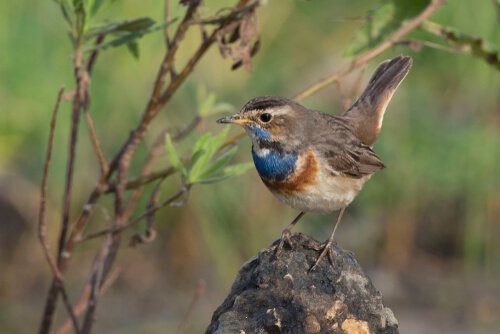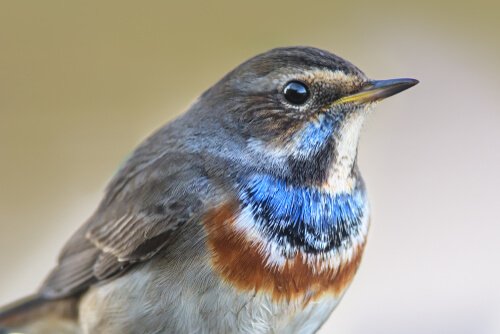Bluethroat Nightingale: All About this Wonderful Bird

As its name indicates, the bluethroat nightingale has bluish plumage—among other colors—on its chest. But this isn’t the only wonderful thing about this bird. Learn more about it in this article.
Bluethroat nightingale description
Its scientific name is Luscinia svecica and it belongs to the passerine group and the Muscicapidae family.
The bluethroat nightingale has a small, slender figure. It measures only 5.5 inches and weighs under an ounce. It has thin legs and a small beak, both grayish in color, and they have black eyes.
What makes this bird stand out are the blue feathers on its chest—hence its name. These feathers may also be accompanied by other colors, like white or orange. Also, the males are much more striking and showy than the females. As with most birds, there is a clear distinction between the sexes.
The rest of its feathers are gray, orange, whitish or yellowish. Also, its head, back, and wings are darker than its face. The feathers on its tail are also very characteristic of this bird: the tip is black and the rest is red or orange.

Bluethroat nightingale behavior and habitat
Some might say that this bird is somewhat ‘shy’ and ‘elusive.’ The females tend to walk on the ground and, as soon as they sense any danger or hear a strange sound, they’ll hide.
The bluethroat nightingale’s song is acute, extensive and melodious. Additionally, they can sometimes imitate the songs of other species, especially those of larks. It usually sings in the mornings and when it gets dark; the males will sing while perched in the bushes.
So far, experts have identified 11 subspecies of bluethroat nightingales. These live anywhere from the Arctic latitudes to the northern Palearctic. This means that you can see them in Scandinavia, Alaska, Asia, and central and western Europe. Some specimens were even spotted in India and North Africa during the migration or hibernation period.
They prefer high mountain areas—between 3,300 and 6,600 feet above sea level during the breeding season. As for the rest of the year, you can find them in wetlands, birch or willow forests, heather thickets, lands close to open meadows, near rivers, lagoons or streams, and in areas with a lot of weeds.

To build its nest, it will look for the slope of a hill or a mountain, near freshwater. In mid-May, it will lay between five and seven green or bluish eggs with reddish spots. Then, after they incubate for two weeks—a task split between the mother and father—the chicks are born. These chicks will be able to fly after only one month of life.
Diet and threats
So, how does the bluethroat nightingale feed? It’s an insectivorous bird whose diet is based on coleoptera, diptera, lepidoptera, aquatic insects and even larvae. Sometimes, they will also eat fruits from wild shrubs and some seeds in autumn.
The bluethroat nightingale’s main threats are grazing, deforestation and the drying up of rivers and streams. All of these alter their natural landscapes. However, it’s not considered in danger of extinction, threatened or vulnerable. Instead, they’re labeled as a ‘minor’ concern because there are still a number of them worldwide.
All cited sources were thoroughly reviewed by our team to ensure their quality, reliability, currency, and validity. The bibliography of this article was considered reliable and of academic or scientific accuracy.
Zink, R. M., Drovetski, S. V., Questiau, S., Fadeev, I. V., Nesterov, E. V., Westberg, M. C., & Rohwer, S. (2003). Recent evolutionary history of the bluethroat (Luscinia svecica) across Eurasia. Molecular Ecology. https://doi.org/10.1046/j.1365-294X.2003.01981.x
This text is provided for informational purposes only and does not replace consultation with a professional. If in doubt, consult your specialist.